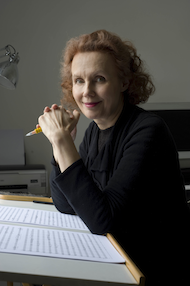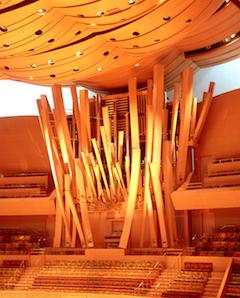
Before the Finnish-born composer, Kaija Saariaho, became a music student at the Sibelius Academy in Helsinki. Before she became friends with a fellow student named Esa-Pekka Salonen. Before she went to Paris to hone her craft at IRCAM. And long before last week’s American premiere of her symphonic composition, Earth Shadows (Maan varjot) with the Los Angeles Philharmonic conducted by Salonen — Kaija Saariaho was an organist.
The irony, Saariaho explained during a preconcert talk at the Walt Disney Concert Hall, is that hardly any of her extensive repertory of musical compositions features the organ.
It was a fortuitous multiple commission from the Orchestre Symphonique de Montréal, the Orchestre National de Lyon, the Southbank Centre and the Philharmonia Orchestra, which offered Saariaho the opportunity to return to her roots. The premiere occasion was the May, 2014 dedication of the new organ at Montréal’s Place des Arts by the Orchestre Symphonique and its principal conductor, Kent Nagano.
As Saariaho describes in the notes for Earth Shadows, the work is not an organ concerto.
“The organ and the orchestra are side-by-side as two rich and powerful ‘instruments’ with several common features between them,” she writes. “But more than the common features, I am interested in the aspects that separate the instruments and give them their own particular identity. For example, the orchestra has great flexibility that comes from the ability to create micro-tonality, glissandos, and rich textures with instrumental noises or delicate multi-layered dynamics. The organ, on the other hand, has the ability to produce rich and very precise textures controlled by only one musician, as well as long sustained notes without the constraints of breathing or the length of a bow. Unlike other instruments, it does not have to fight to rise above the orchestra.”

During the more than three decades of her compositional odyssey, Saariaho has morphed from a post-serialist (studying with Brian Ferneyhough in Friburg), to a composer of spectral compositions with an emphasis on electronics (at IRCAM where she worked with Gérard Grisey). Her present style, which is not easily categorized, emphasizes a vast palette of orchestral coloration, intricate rhythmic interactions, and an entire cosmology of instrumental atmospherics.
Earth Shadows is superb example. Its three contrasting movements, designated simply I, II, and III, employ full orchestra with an extensive battery of diverse percussion instruments and the organ — in this case the mighty voice of the Disney Hall organ (dubbed “French Fries" and "Hurricane Mama” by Terry Riley) which is celebrating its 10th anniversary this year. The soloist was the French organist, Olivier Latry, who, to this point, has been the sole interpreter of the piece.
Earth Shadows (the title is drawn from Shelley’s “Ode to John Keats”) begins with a sense of trembling intensity from the low strings and organ which is quickly contrasted by twinkling high notes from the organ’s highest register, tintinabulating bell tones and bird-like chirps from the winds. At times the organ blends into the orchestral fabric as a rumbling, pulsing, growling presence. Then like a magma pool no longer under restraint, it bursts forth in eruptive crescendos of full-voiced magnitude causing tectonic shifts in the orchestral landscape.
The second movement, which Saariaho refers to as “the heart of the composition,” is more elegiac and spectral in nature. The organ and orchestral lines glisten in ghostly phrases as if we listening to the lingering spirit voices at Miss Havisham’s wedding. The music, though perhaps not literally intended, takes on a gothic quality reminiscent of the shadowy regions of Edgar Alan Poe or Emily Bronte.
When the organ opens at full volume producing enormous declaiming chords at begin the third movement, the tone takes on a certain demonic Phantom of the Opera quality. The drawn out spectral nature of the second movement gives way to rapid pulse attacks particularly in the mallet instruments. There are thunderclaps of intensity from the organ and fusillades of exclamation points in the brass.
Designed as it is for symphony halls with imposing in-house organs, it seems likely that Earth Shadows may find its way to Davies SymphonyHall, hopefully again under the evocative, atmospheric leadership of Esa-Pekka Salonen.

